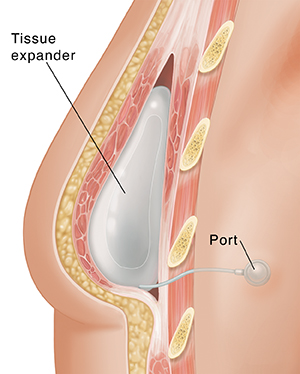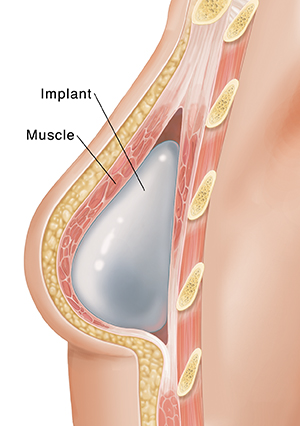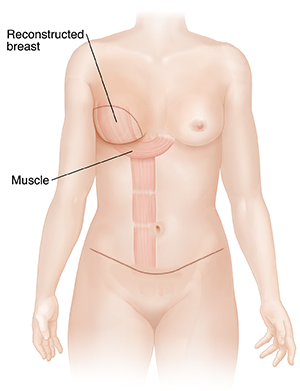Breast Augmentation/Reconstruction
Breast Reconstruction with Implants
Deciding on breast reconstruction
There are many choices for breast reconstruction after having surgery to remove a breast (mastectomy). Your surgeon can help you decide whether you're able to have reconstructive surgery and what kind is best for you. You may need to wait if now isn't the best time for you. For instance, you may be advised to wait if you need radiation treatments after surgery. Breast reconstruction can be done months or even years after mastectomy.
Delayed breast reconstruction
For this choice, the breast area is prepared for a breast implant with a tissue expander. This is an empty implant shell that's put in during the mastectomy. You'll be given time to heal and recover from surgery. When you're ready, the tissue expander is slowly filled with fluid or air over several weeks. This is done to gently stretch the skin and muscle to make room for the implant. If needed, you might have chemotherapy during this time.
When the muscle and skin are stretched enough, a surgeon can replace the expander with a permanent implant. If you're having radiation therapy, the final implant will be put in after that treatment is completed.

Immediate breast reconstruction
This is a choice if you aren't having radiation therapy after surgery. The surgeon will place the implant at the same time they perform the mastectomy. Sometimes more surgery is needed to get the final shape and look.
Placing the implant
Most breast implants are shells filled with fluid (saline) or thick, gummy gel (silicone). The implant is placed under your chest muscle. Sometimes an acellular dermal matrix is used like a sling to hold it in place. Recovery may take up to 6 weeks. It may take many months before the bruising and swelling go away and you can see the final results.
Sometimes more surgery is needed to complete the reconstruction. For instance, you might want a nipple and areola created. Surgery may also be needed to match your remaining breast to the reconstructed one. Expect the reconstructed breast to be firmer than your normal breast. Implants don't last forever and will need to be replaced at some point in the future.

Risks of breast implant
Any type of surgery has some risk. Some problems related to breast reconstruction with implants include:
-
Bleeding
- Infection
-
Fluid collection in the surgical area (seroma)
-
Problems with the medicines (anesthesia) used to do the surgery
-
Bruising and swelling
-
Trouble healing
-
Implant problems, such as leaking, breaking, or coming through the skin
-
Implant rejection
-
Breast implant-linked anaplastic large cell lymphoma. a rare type of T-cell lymphoma cancer
-
Scar tissue which can cause the breast to feel painful, hard, and cold to the touch
The most common problem of breast reconstruction done with implants is called capsular contracture . This is when the scar or capsule around the implant begins to tighten and become hard. In some cases, this and other problems are bad enough to need another surgery.
Women who smoke are at higher risk for problems after surgery. These include slow healing, more noticeable scars, and taking longer to recover. Talk with your healthcare provider and get help quitting before surgery.
Also keep in mind that you may not be happy with the final outcome.
Implant maintenance
Ask your surgeon how long your implants should last. Also ask what signs of a problem you should watch for and when to seek help. The FDA recommends that women with silicone implants get routine MRI screenings to check for signs that an implant is leaking or broken.
Work with your healthcare team
Talk with your healthcare provider about the pros and cons of each type of breast reconstruction surgery. Also talk about your implant choices. There are many different kinds available in different sizes, textures, and shapes. Be sure you know what to expect your breasts will look and feel like after surgery. Learn as much as you can before deciding what's best for you.
Breast Reconstruction with Flap Procedures
Breast Reconstruction with Flap Procedures
A flap procedure uses your own tissue to form the shape of a breast Common types of flap procedures using abdominal tissue are the TRAM and DIEP flaps. The LD flap using back tissue may also be done. Less often, tissue may be moved to the chest from the buttocks or thigh.
These surgeries are named based on what part of the body the flap tissue is taken from.
Tissue flaps look and feel more like natural breast tissue. But flap reconstruction surgeries leave you with 2 surgical wounds. These are the chest and the site where tissue was taken.
Getting breast reconstruction surgery
Your surgeon can help you decide whether to have reconstructive surgery and what type is best for you. You might be advised to wait if now is not the best time for you (delayed reconstruction). For instance, you may be advised to wait if you need to get radiation to your chest after surgery. You may also choose to have breast reconstruction right after your cancer is removed (immediate reconstruction).
Breast reconstruction might not be an option if you smoke, have a connective tissue disease, have uncontrolled diabetes, or have circulation problems. These things can cause blood vessel problems. Healthy blood vessels are needed to support the tissue flap. Some people choose not to have breast reconstruction.
Talk with your healthcare provider about what the surgery is like and what you can expect after surgery. Be sure you know what your breast shape will look and feel like and how the donor flap site might be affected.
TRAM flap
TRAM stands for transverse rectus abdominis myocutaneous. A TRAM flap uses stomach muscle, fat, blood vessels, and skin.
The flap is taken from the lower part of your stomach. It may be tunneled under your skin from your stomach to your chest. Or it may be cut free and moved there. The flap is then formed into the shape of a breast. The new breast shape feels soft to the touch. This surgery also makes your belly flatter and tighter, as if you had a "tummy tuck." It can also decrease the strength in your belly muscles.

DIEP flap
DIEP (deep inferior epigastric perforators) flap uses fat, skin, and blood vessels from your lower belly to rebuild your breast. No muscles are used. Since no muscles are used, DIEP flap may have a shorter recovery time. You may have less risk of losing muscle strength compared with a TRAM flap.
LD flap
The LD (latissimus dorsi) flap uses muscle, fat, and skin from your upper back. The flap of skin and fat is taken from the back side of your body, over your ribs. The latissimus dorsi muscle is left attached to the flap. Then the flap is tunneled under your skin to your chest. There, it's formed into the shape of a breast. The new breast feels soft to the touch. In many cases, an implant is needed with this surgery.

Nipple reconstruction or nipple tattooing
You may be interested in nipple reconstruction or tattooing. This step is typically done several months after breast reconstruction surgery so the breasts can heal. It's rare for nipple reconstruction to be done during breast reconstruction surgery because the nipples may be positioned poorly. Nipple reconstruction surgery is usually done by a plastic surgeon as an outpatient procedure. The surgeon may use skin from the breast area where the nipple will be. The reconstructed nipple may be tattooed later to add color. You likely won't have feeling in the reconstructed nipple. It may flatten over time.
Some people choose nipple tattooing instead of nipple reconstruction surgery if they don't want another surgery or prefer the appearance of the tattoo. 3D tattooing makes a nipple that appears to have shape but is actually flat. They can also recreate the areola. The tattoo may be done by a staff member at a surgeon's office or a qualified tattoo artist. Wait until you are cleared by your surgeon to have nipple tattooing. Ask your healthcare team if they recommend a certain trained tattoo artist.
Some people may not be able to have nipple reconstruction or tattooing. This includes people who have lymphedema that involves the chest, a history of infections in the breast area, breast skin damaged by radiation, or breast skin that is thin from surgery.
Talk with your healthcare provider about what options they recommend for you. Visit the American Cancer Society at www.cancer.org or breastcancer.org for more information on nipple reconstruction or tattooing.
Risks of flap reconstruction
Any type of surgery has some risk. Some problems linked to breast reconstruction with a flap are:
-
Bleeding
-
Fluid collection in either surgery spot (called a seroma)
-
Anesthesia problems (problems with the medicines used to do the surgery)
-
Bruising and swelling
-
Implant problems
-
Infection
-
Muscle weakness
-
Scars and scar tissue under your skin
- Blood clots
-
Problems at the donor site, such as muscle weakness or abdominal hernia (with TRAM flap)
- Loss of the flap because of tissue death
Your surgeon will talk with you about the risks of surgery. Ask all your questions so you understand what breast reconstruction will be like during and after surgery. This way you can make the decision that's best for you.